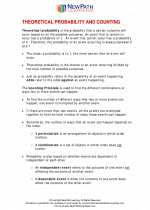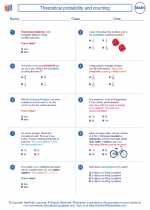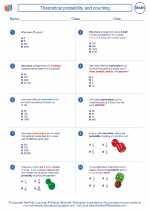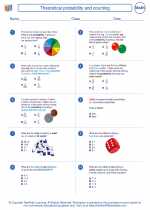Theoretical Probability and Counting
Counting Principles
Fundamental Counting Principle
The fundamental counting principle states that if there are m ways to do one thing, and n ways to do another, then there are m * n ways of doing both.
Permutations
A permutation is the arrangement of objects in a specific order. The number of permutations of n distinct objects taken r at a time is given by the formula: nPr = n! / (n - r)!
Combinations
A combination is a selection of objects without considering the order. The number of combinations of n distinct objects taken r at a time is given by the formula: nCr = n! / (r! * (n - r)!)
Theoretical Probability
Sample Space
The sample space is the set of all possible outcomes of an experiment. It is denoted by S.
Event
An event is a subset of the sample space, representing the outcomes of interest.
Probability of an Event
The probability of an event A, denoted by P(A), is the ratio of the number of favorable outcomes to the total number of possible outcomes.
Study Guide
Fundamental Counting Principle
Use the fundamental counting principle to determine the number of outcomes for a given scenario.
Example
If there are 3 different shirts and 4 different pants, how many different outfits can be created?
Solution: By the fundamental counting principle, the number of different outfits is 3 * 4 = 12.
Permutations
Use the permutation formula to calculate the number of arrangements of objects.
Example
How many different 3-letter arrangements can be made using the letters A, B, C, and D?
Solution: The number of permutations is 4P3 = 4! / (4 - 3)! = 4 * 3 * 2 = 24.
Combinations
Use the combination formula to calculate the number of selections of objects.
Example
A committee of 5 members is to be formed from a group of 10 people. How many different committees can be formed?
Solution: The number of combinations is 10C5 = 10! / (5! * (10 - 5)!) = 252.
Theoretical Probability
Calculate the probability of an event using the ratio of favorable outcomes to total outcomes.
Example
What is the probability of rolling a 3 on a fair six-sided die?
Solution: The probability is P(3) = 1/6.
By mastering the fundamental counting principle, permutations, combinations, and theoretical probability, you will have a solid foundation in understanding and calculating probabilities in various scenarios.
.◂Math Worksheets and Study Guides Eighth Grade. Theoretical probability and counting

 Worksheet/Answer key
Worksheet/Answer key
 Worksheet/Answer key
Worksheet/Answer key
 Worksheet/Answer key
Worksheet/Answer key
